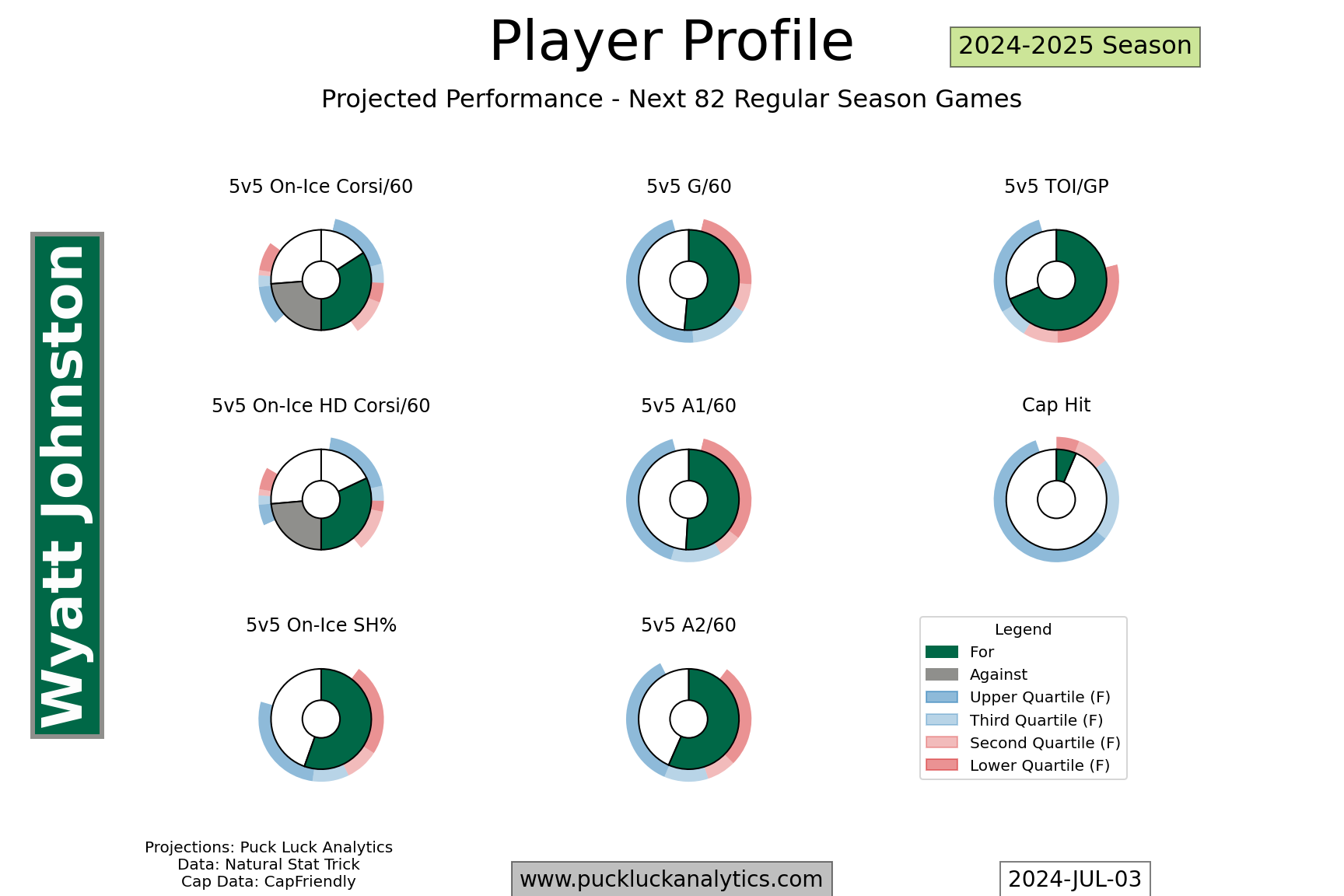In the last couple of posts, I’ve put together roadmaps for a couple of teams in very different positions. The Calgary Flames are in the midst of a roster selloff as they try to rebuild a competitive roster from the ground up. The Edmonton Oilers are at the opposite end of the spectrum, fully in win now mode trying to keep their window open as long as possible. We had to put in some effort in both cases to put together a plan to transition each roster to a regenerative cohort plan. Now, let’s look at a team that is much closer to having regenerative cohorts already in place and build a Dallas Stars roster roadmap.
The Stars have had waves of players hitting the NHL out of their prospect system over the past few years. Their trip to the 2020 Stanley Cup Final was powered by a group led by Jamie Benn and Tyler Seguin. Since then, they’ve transitioned to a younger group leading their NHL roster while missing the playoffs just once in the process in 2021. They’ve become a power in the Western Conference again with their 2017 draft class now leading the way and we saw another wave of young talent hit their NHL roster last season.
Dallas Stars Roster Roadmap
The Stars have been to the Western Conference Final for two straight seasons, so they’re clearly well positioned as contenders for the time being. With their 2017 draft class now anchoring their roster, their core has plenty of runway left and young players pushing their way onto the NHL roster leaves plenty to work with for the longer term plan. Thomas Harley remains an RFA as training camp approaches so his deal is a question mark for the long term outlook. However, the Stars have a fairly flexible cap outlook for the long term regardless of the type of deal Harley inks.
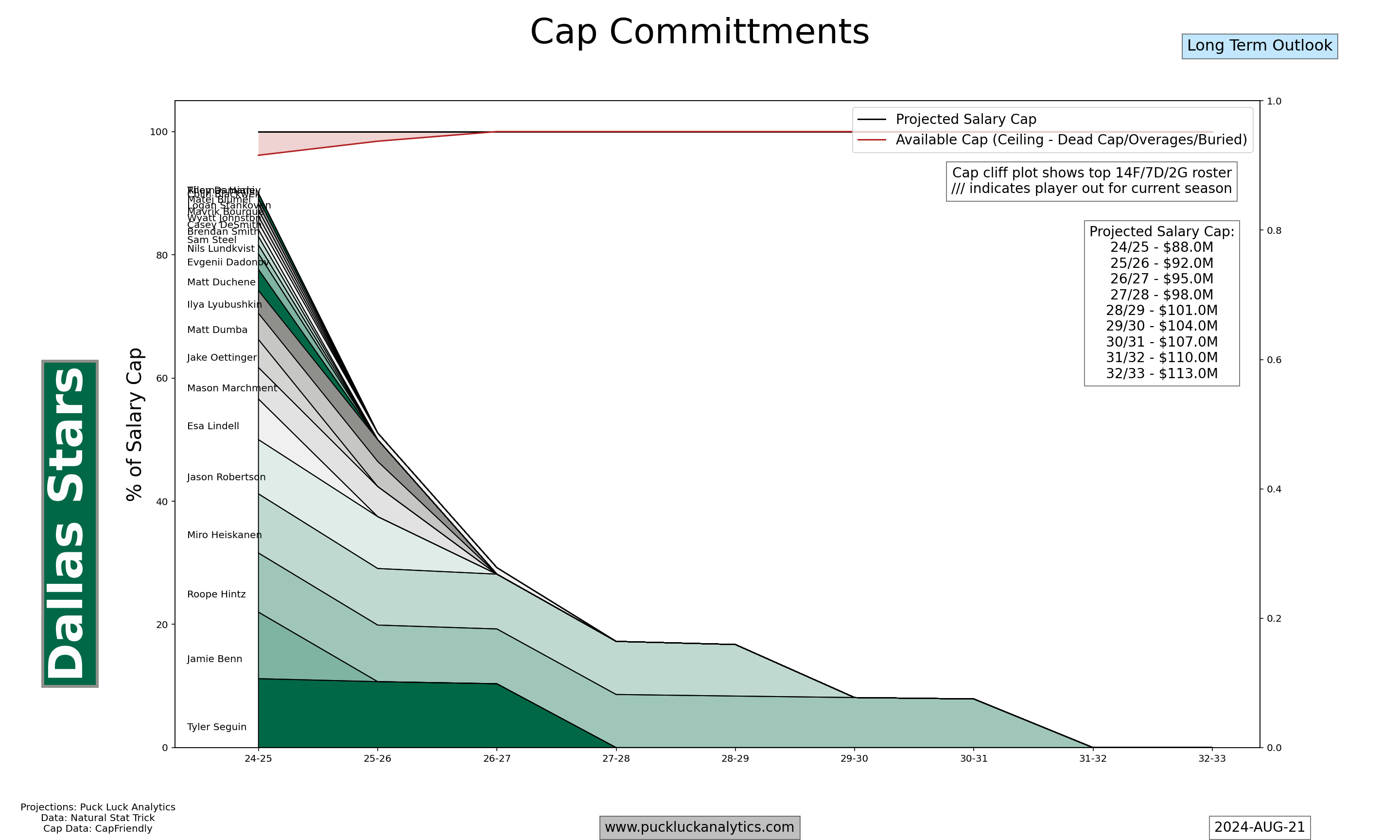
Primary Cohort
The Stars roster is currently driven by their 2017 draft class. Jason Robertson, Miro Heiskanen and Jake Oettinger are a great starting point for a contention cohort and are early in their prime at age 25. We could include Roope Hintz, who is a couple of years older, however there aren’t a lot of great options to build out the cohort if we start there. Instead, there is a group of players a few years younger that we’ve recently seen burst onto the NHL scene. We’re going to be a bit flexible with cohort theory and use a five year window here (instead of four) to fill out a strong primary cohort that is just entering it’s prime.
Let’s start by building out the primary cohort, looking for a group of 6 forwards, 3 defensemen and a goalie in a group currently age 21-25. Players are listed below with the following information: Position – Player (Age / Cap Hit / Years Remaining Under Contract).
Forwards
F – Jason Robertson (25 / $7.75MM / 2y): Robertson is the obvious starting point up front for the primary cohort. He became an NHL regular in 2020-2021 and was an Elite Tier forward immediately. Last season was a rough one by Robertson’s standards, but at this point it looks like the outlier. He should be an Elite Tier forward for the primary cohort.
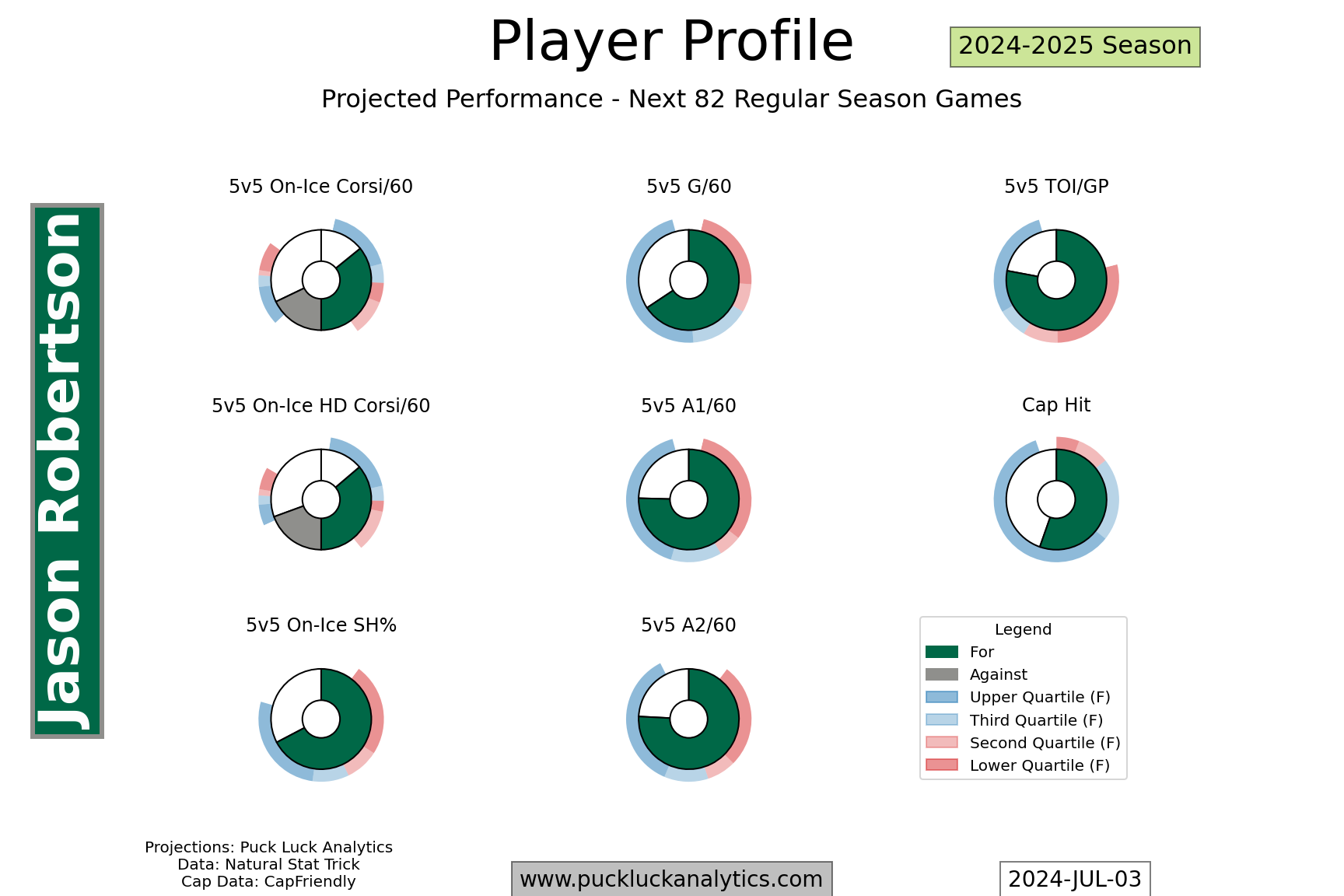
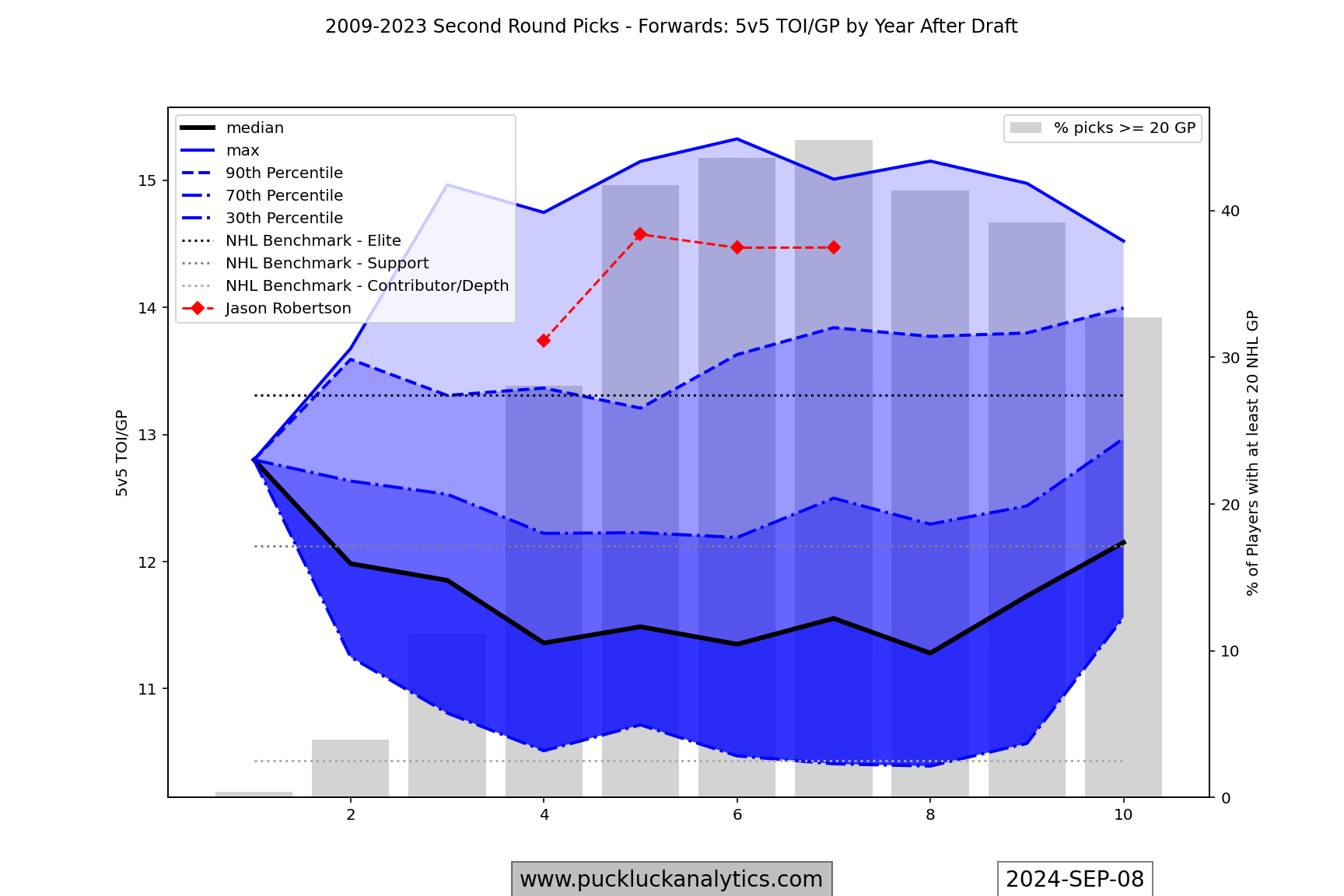
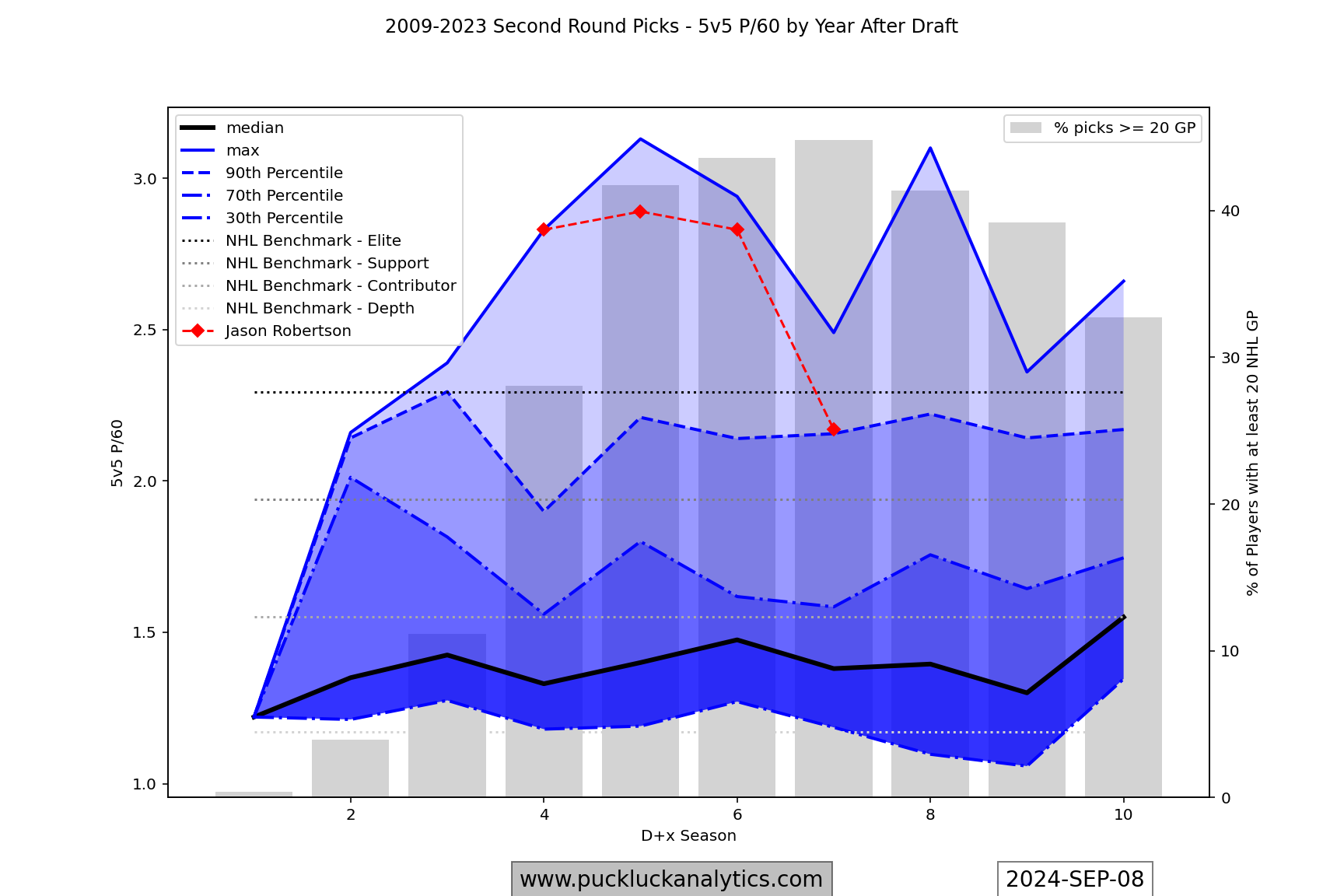
F – Wyatt Johnston (21 / $894k / 1y): Wyatt Johnston has risen up the depth chart quickly during his first two NHL seasons. He followed up a strong rookie season with an even more impressive sophomore campaign. He looks like a good bet to be at least a Support Tier forward through his prime and another strong showing this season could give some confidence he may even make the Elite Tier. At age 21, we have to bend the theory and expand the cohort to a five year window but doing so gives us a strong cohort bookended by Johnston and Robertson.
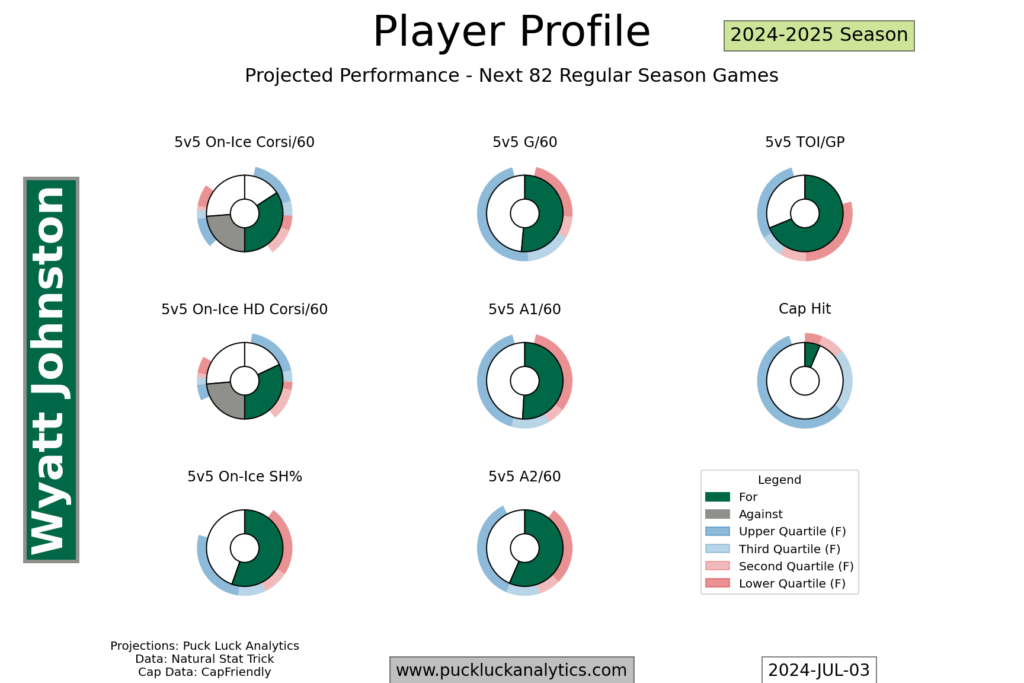
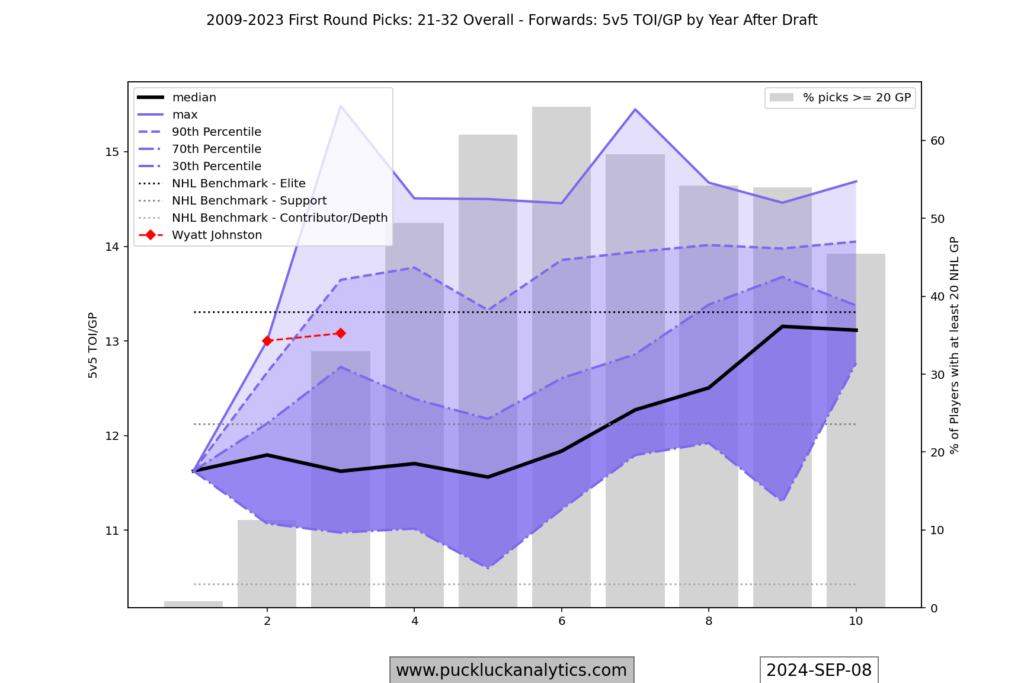
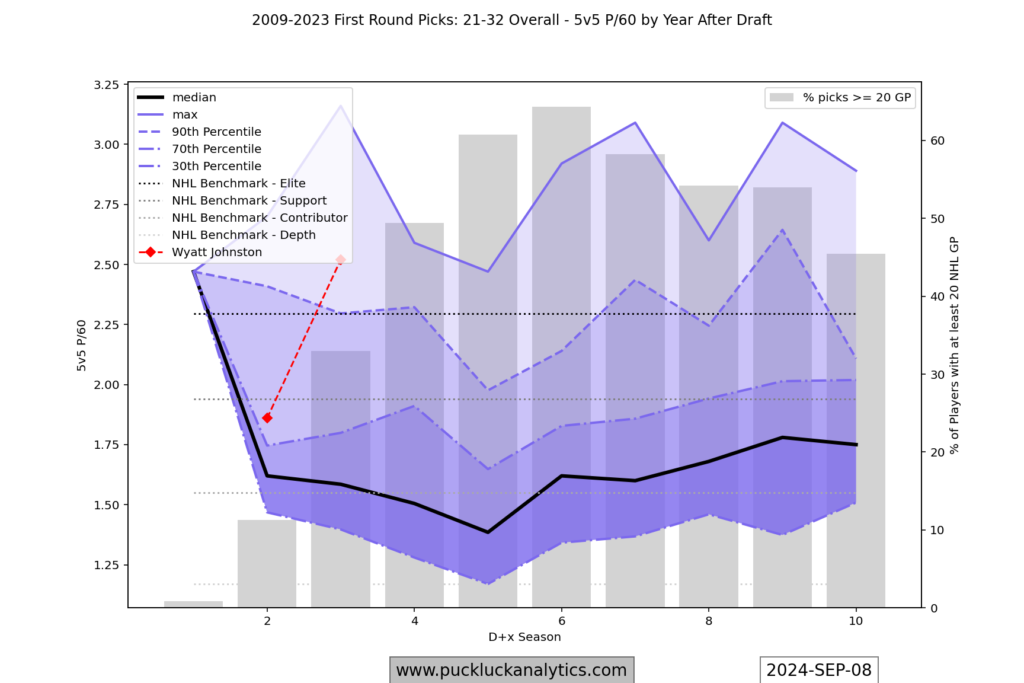
F – Logan Stankoven (21 / $814k / 2y): Another 21 year old, Stankoven made a statement when he was called up mid season last year. He was among the roughly 10% of second round picks to play at least 20 NHL games in his D+3 season and he looked very good in his initial foray into the NHL. Stankoven looks like a good bet to be another Support Tier forward.
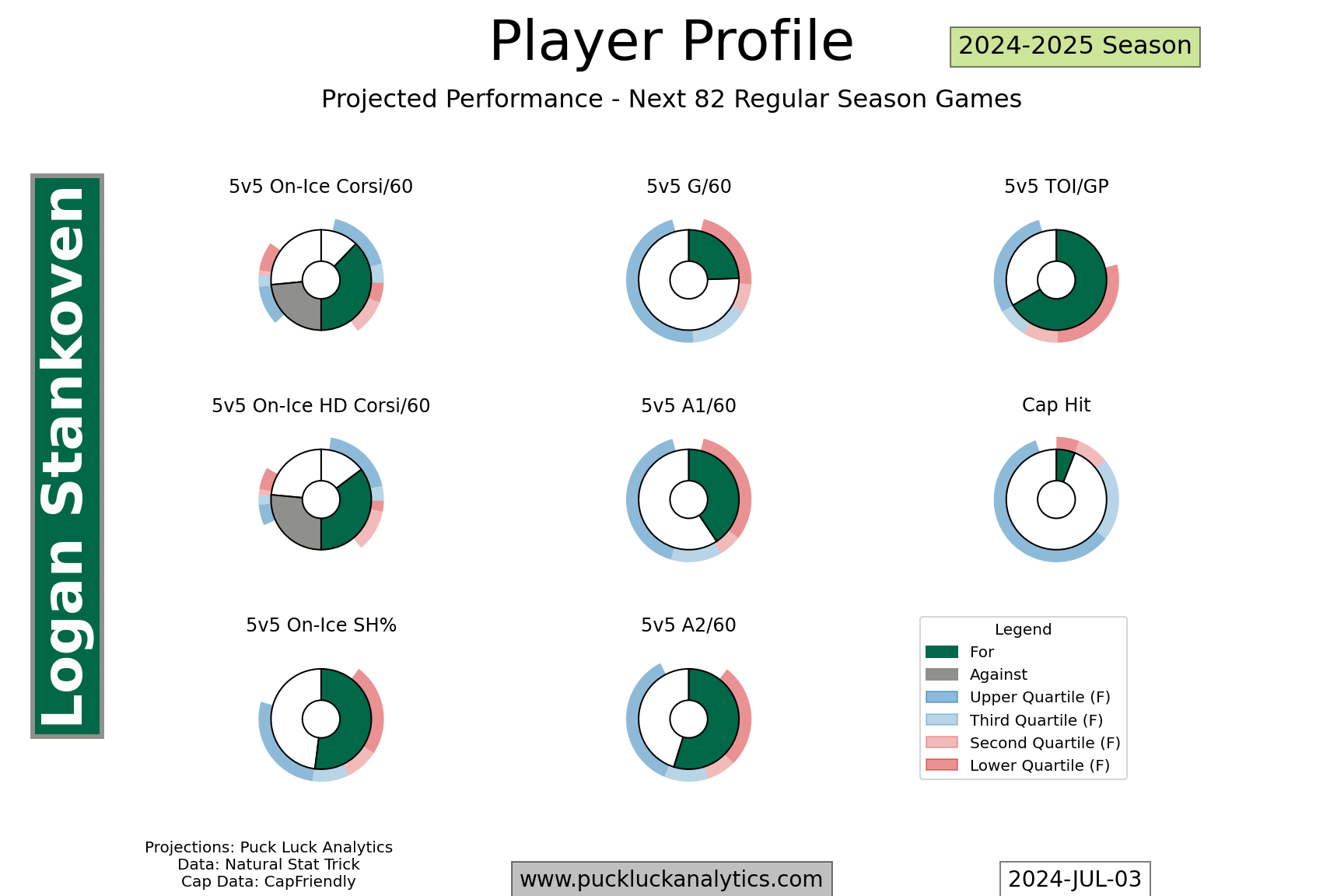
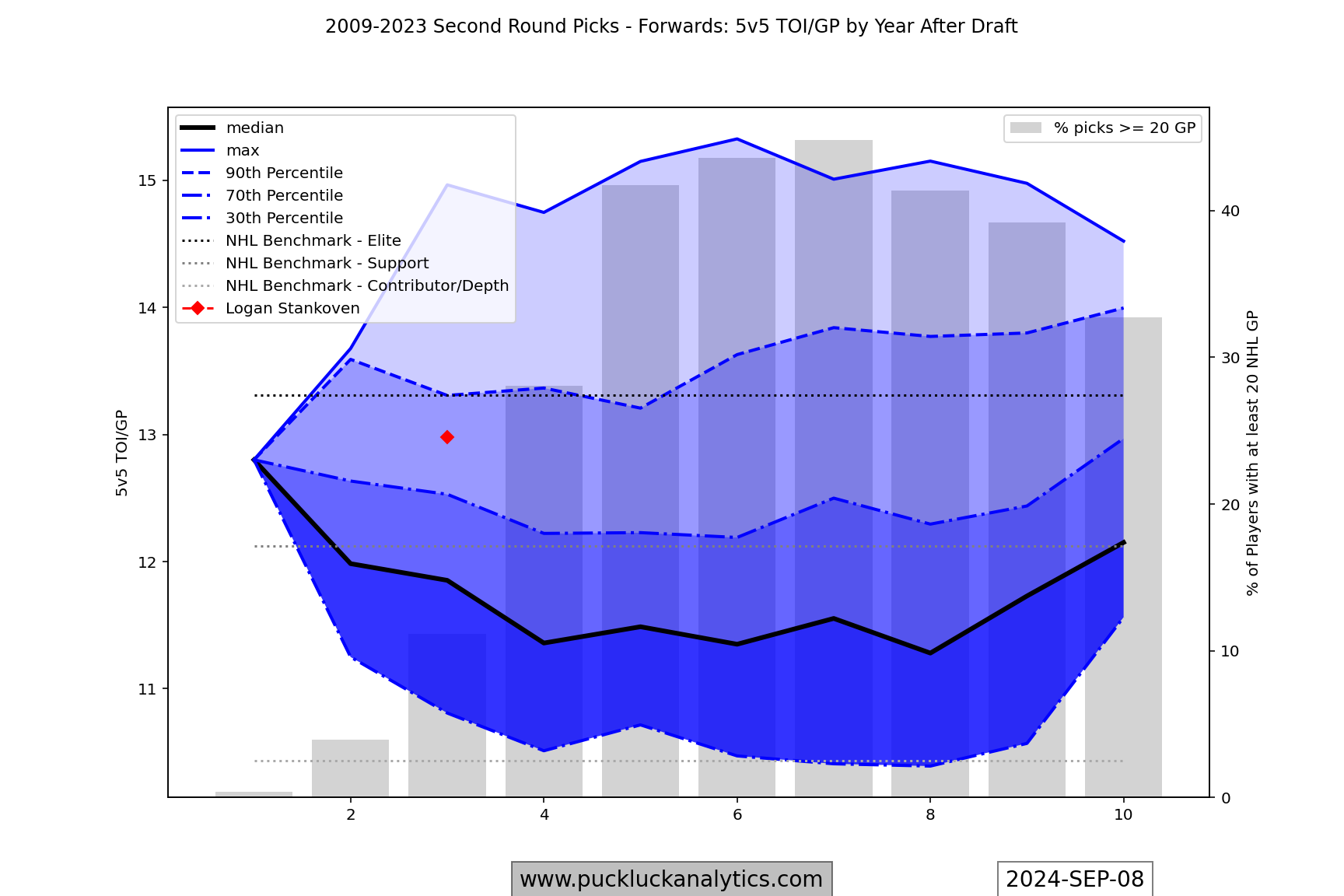
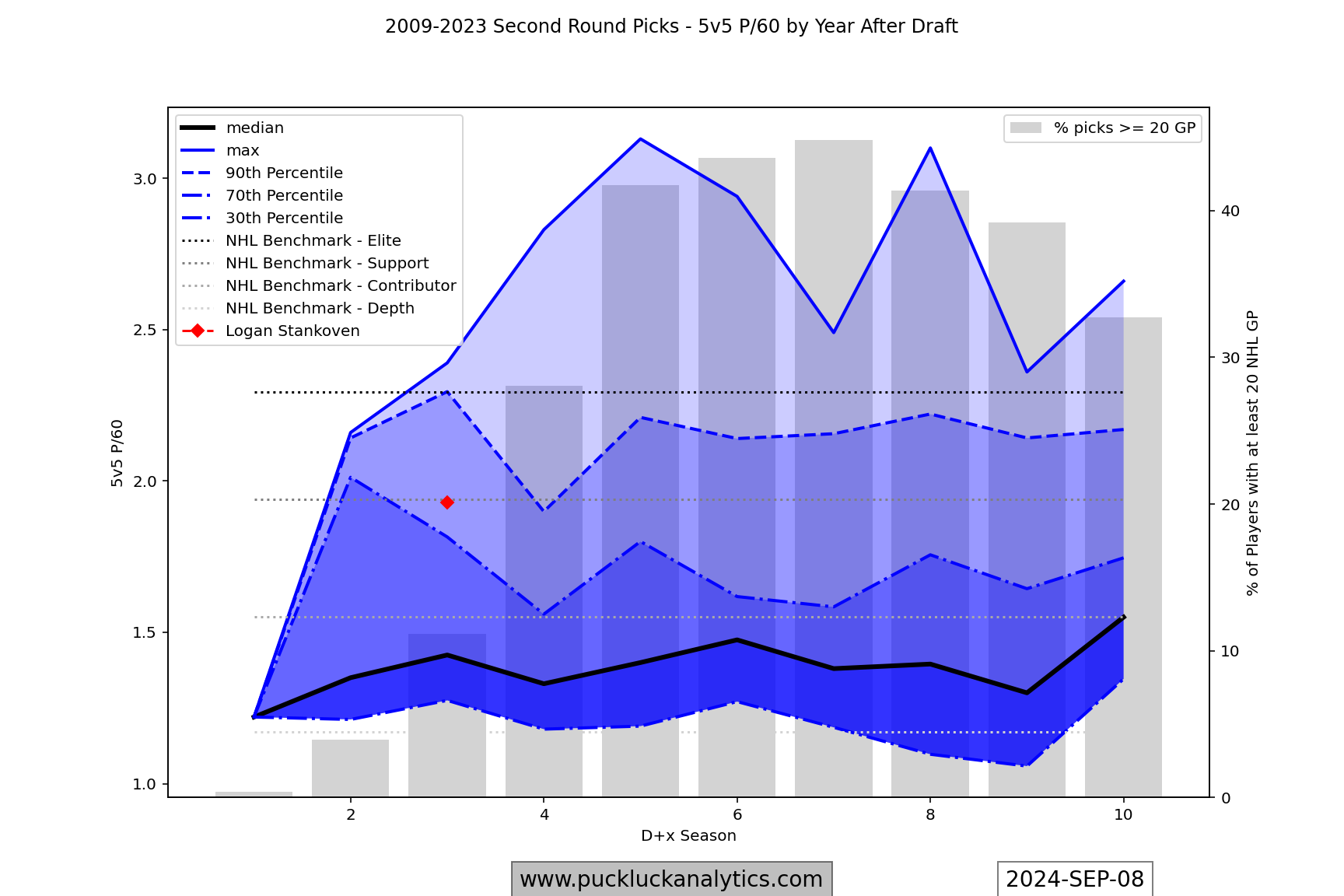
F – Mavrik Bourque (22 / $894k / 1y): Bourque made his NHL debut last season but we haven’t seen enough of him in the NHL to make any grand conclusions yet. He’s a highly touted prospect who has spent parts of the last two seasons tearing up the AHL with Stankoven though. A Contributor Tier forward feels like a reasonable expectation for his prime.
F – Matej Blumel (24 / $775k / 1y): Another prospect who’s spent the last couple of season in the AHL, our hope is Blumel can establish himself in the NHL. Already 24, he’ll need to do it soon and we’re going to assume he’s only a Contributor Tier forward for the cohort. If Blumel doesn’t pan out, 26 year old Sam Steel may be a suitable fill in for the short term.
F – Roope Hintz (27 / $8.45MM / 7y): Hintz is a couple of years older than the bounds of our cohort. He’s one of the Stars top forwards though and he needs to be a part of the long term plan. We’ll approach this like we did McDavid and Draisaitl in the Oilers roadmap: Hintz is an anchor talent that can help us bridge the gap between the veteran and primary cohorts. He’s had few outstanding seasons interspersed with very good seasons so we’ll consider him as a Support Tier forward as a floor. With any luck, we’ll be able to replace him in the primary cohort eventually and shift him into the veteran group.
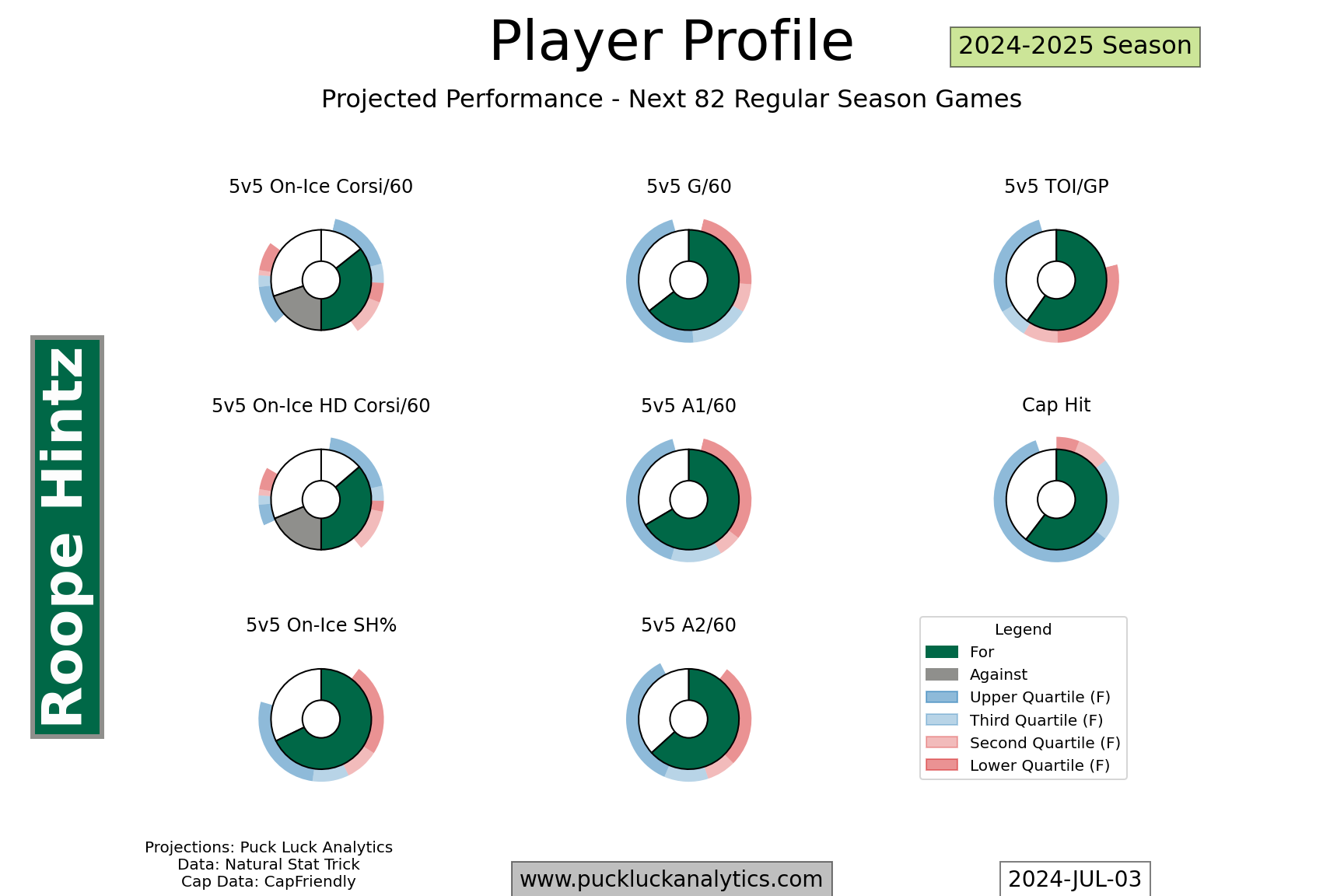
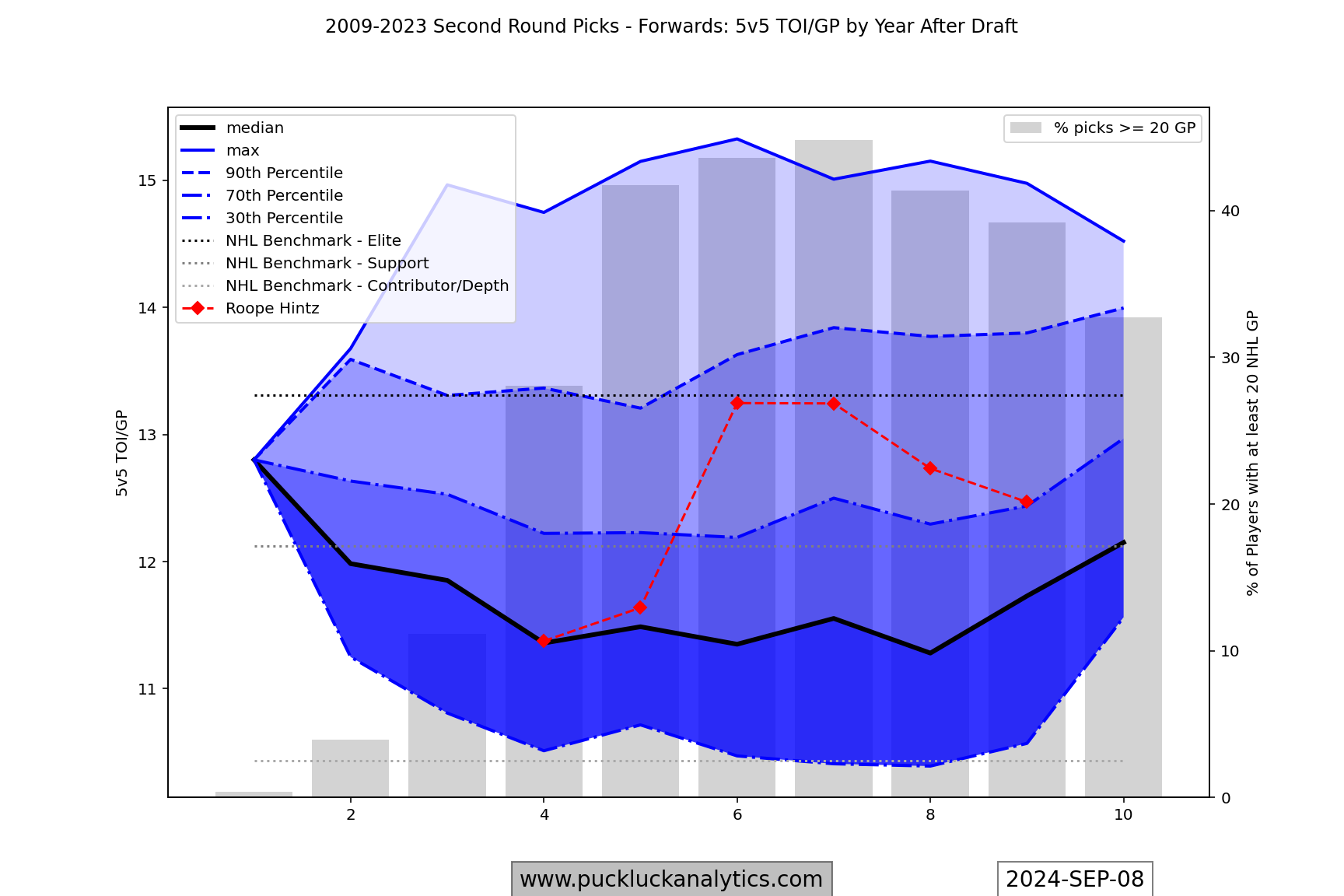
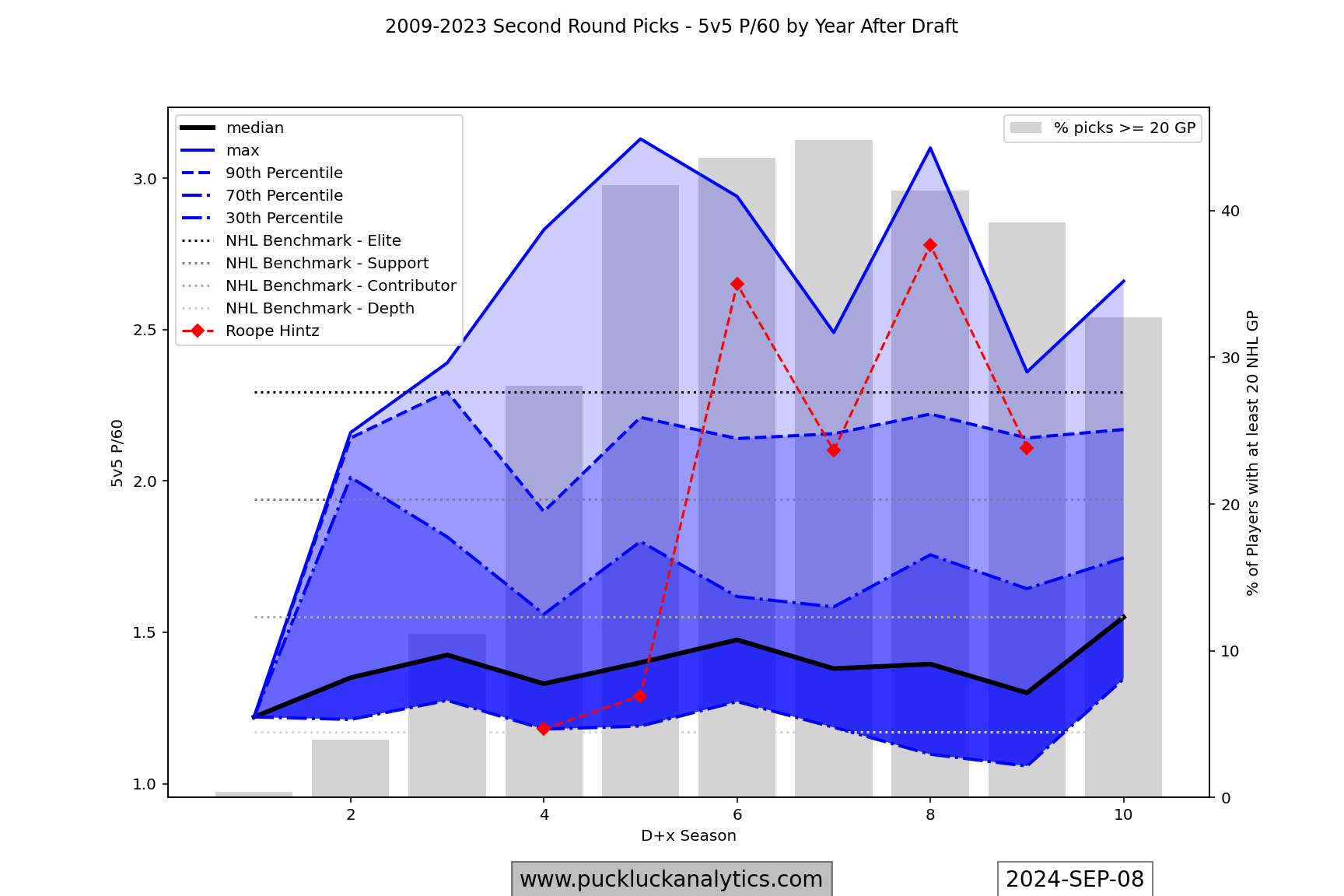
Defensemen
D – Miro Heiskanen (25 / $8.45MM / 5y): Heiskanen’s name has started coming up in Norris Trophy discussions over the past few seasons and with good reason. He’s been a workhorse on the Stars blue line for his entire career and his production has been average relative to defensemen picked in the 2nd – 5th overall range.
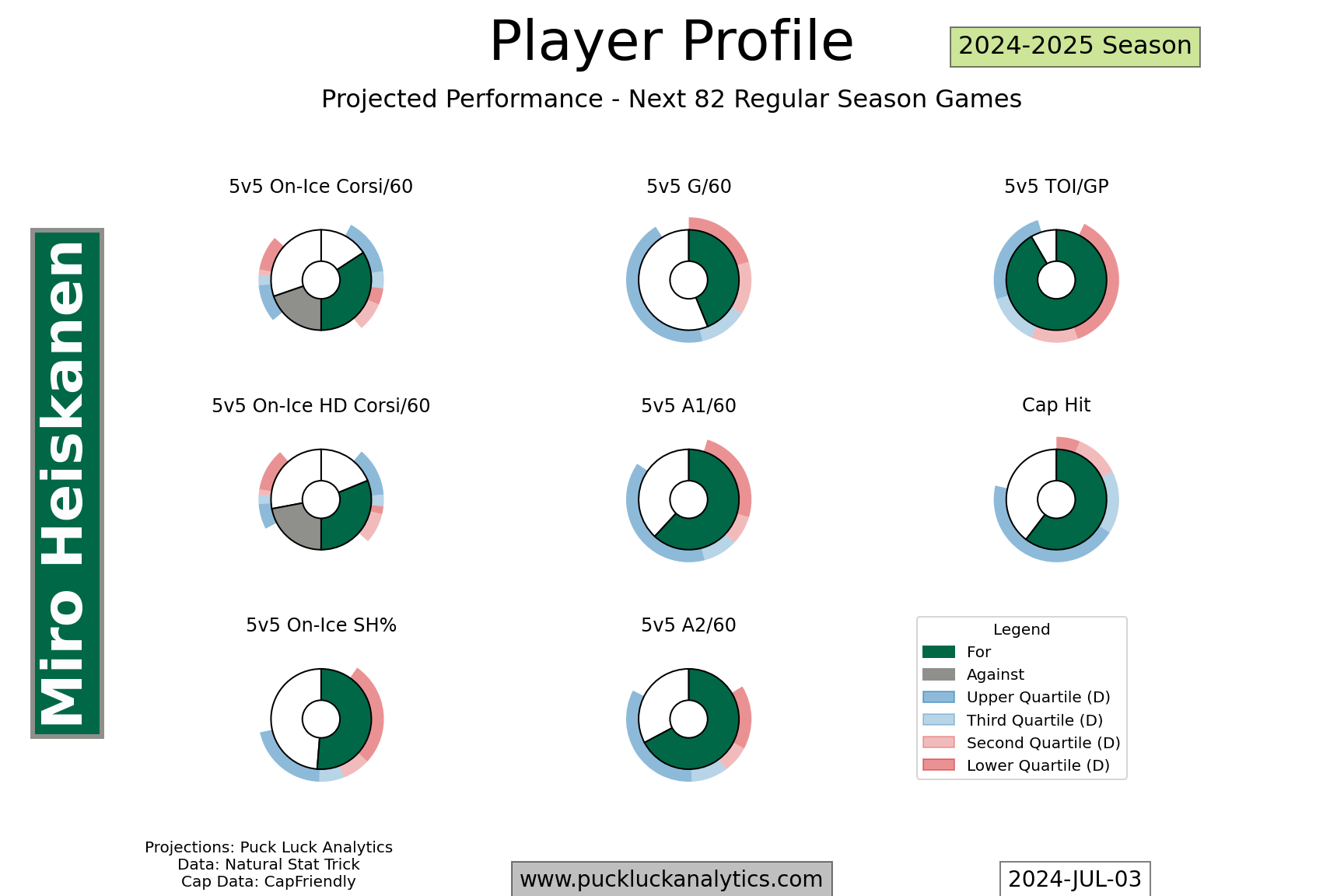
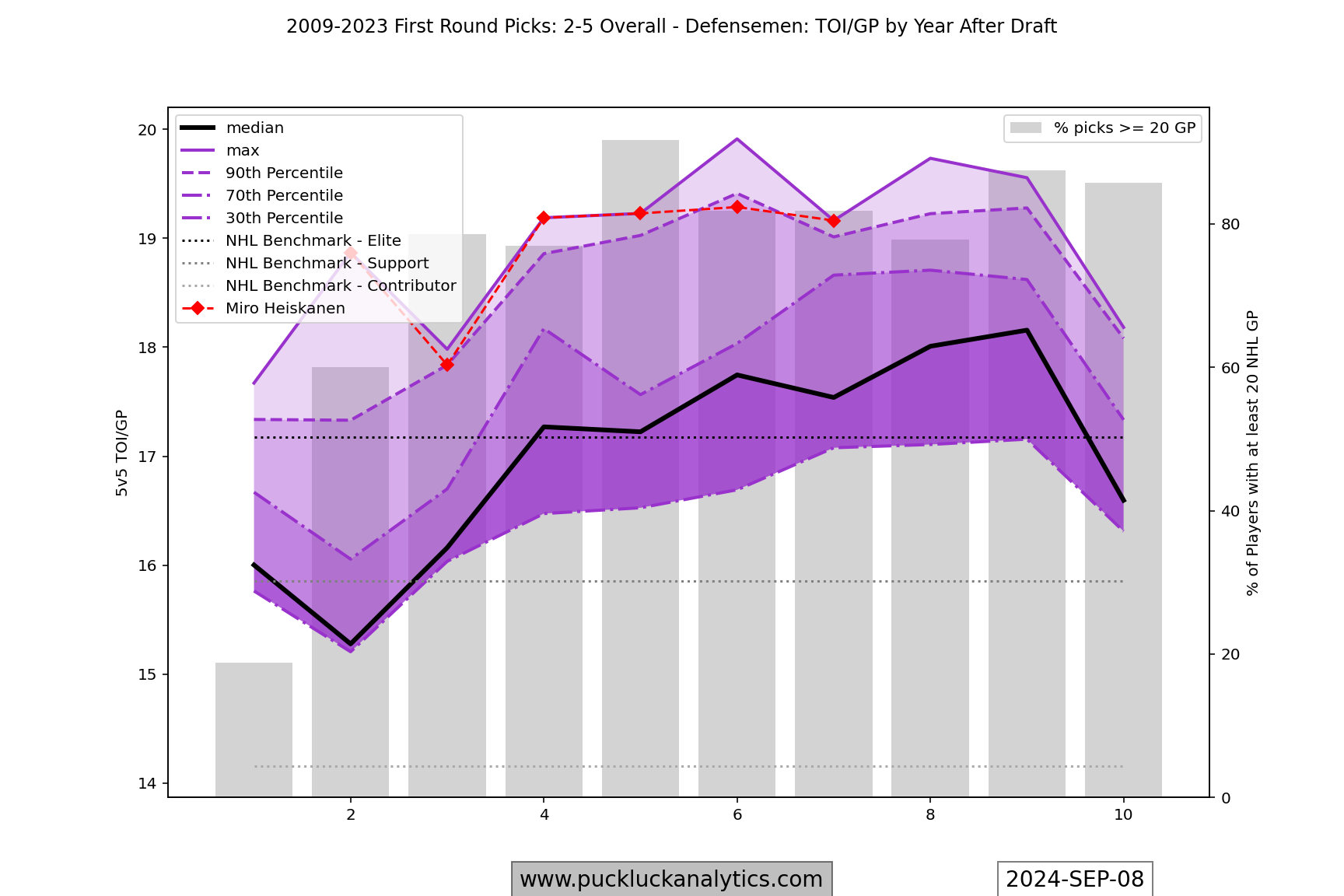
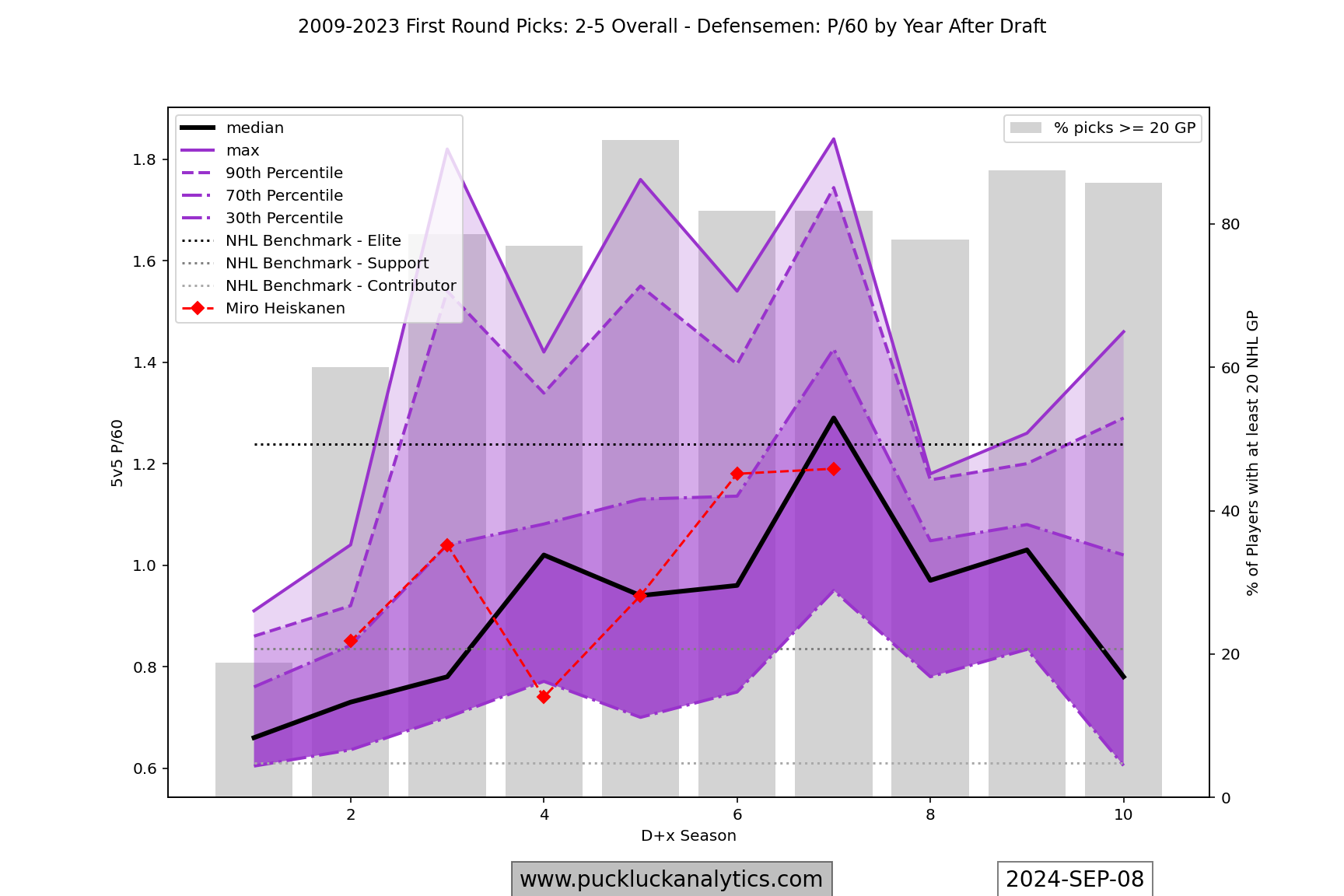
D – Thomas Harley (23 / RFA / RFA): Harley arrived in the NHL during the 2023 playoffs and he hasn’t looked back since. He became a big part of the Stars D-corps last season, providing some offensive pop from the back end. Maintaining that output for a second straight season would give us more confidence that it wasn’t an outlier season. Even with a small drop off, a Harley/Heiskanen pair is a great starting point to build a defense corps.
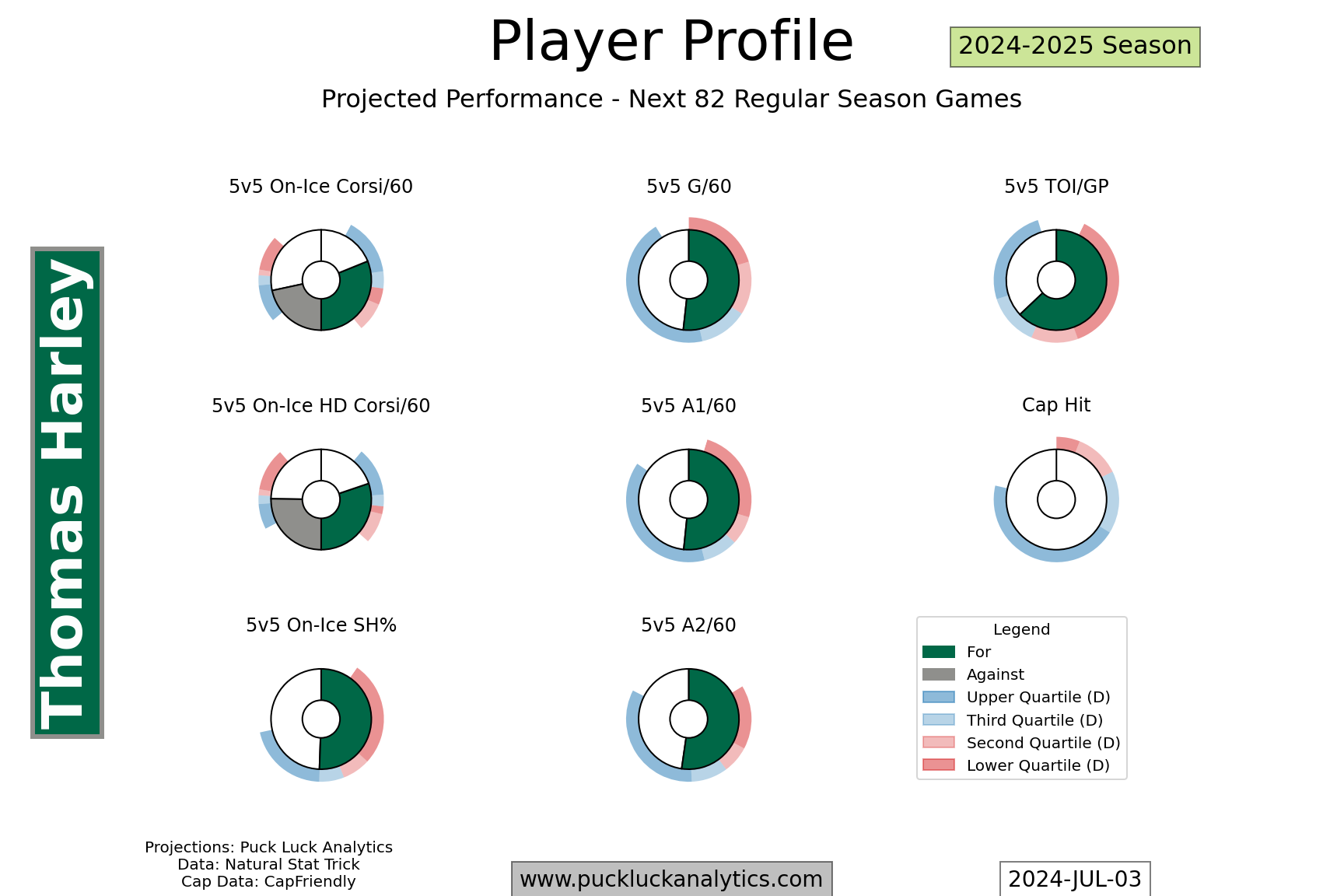

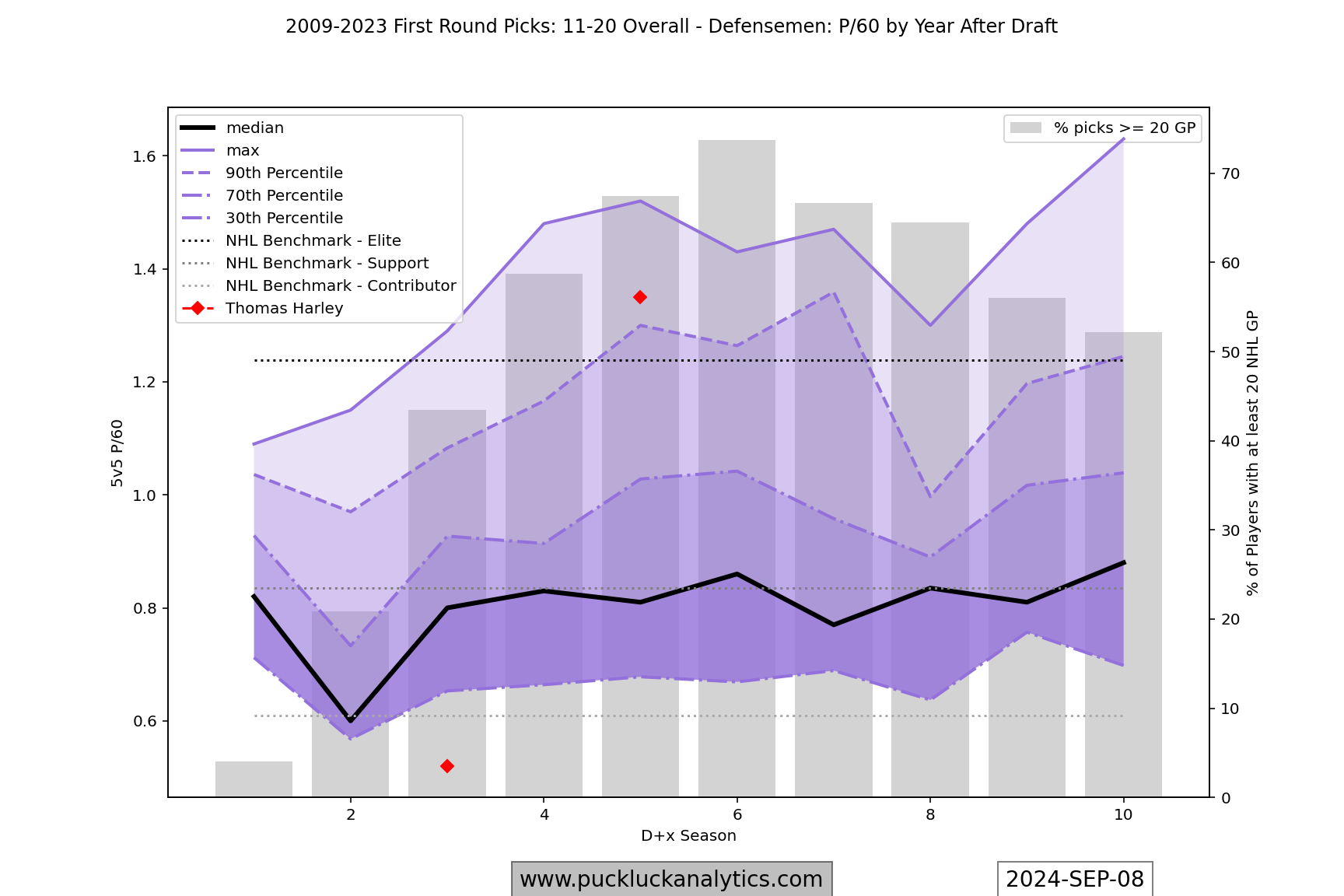
D – Nils Lundkvist (24 / $1.25MM / 1y): Lundkvist hasn’t been able to gain much traction at the NHL level with stops in New York and Dallas thus far in his career. He lost his regular spot in the lineup in the playoffs last spring, so it may be that his time in Dallas is nearing an end. While he hasn’t been able to work his way up the depth chart, his production relative to his draft peers has been rising quickly over the past couple of seasons. We definitely want to keep a close eye on his play going forward, but there’s enough reason for optimism that Lundkvist can settle in as a Contributor Tier defenseman for the primary cohort to include him in the group right now.
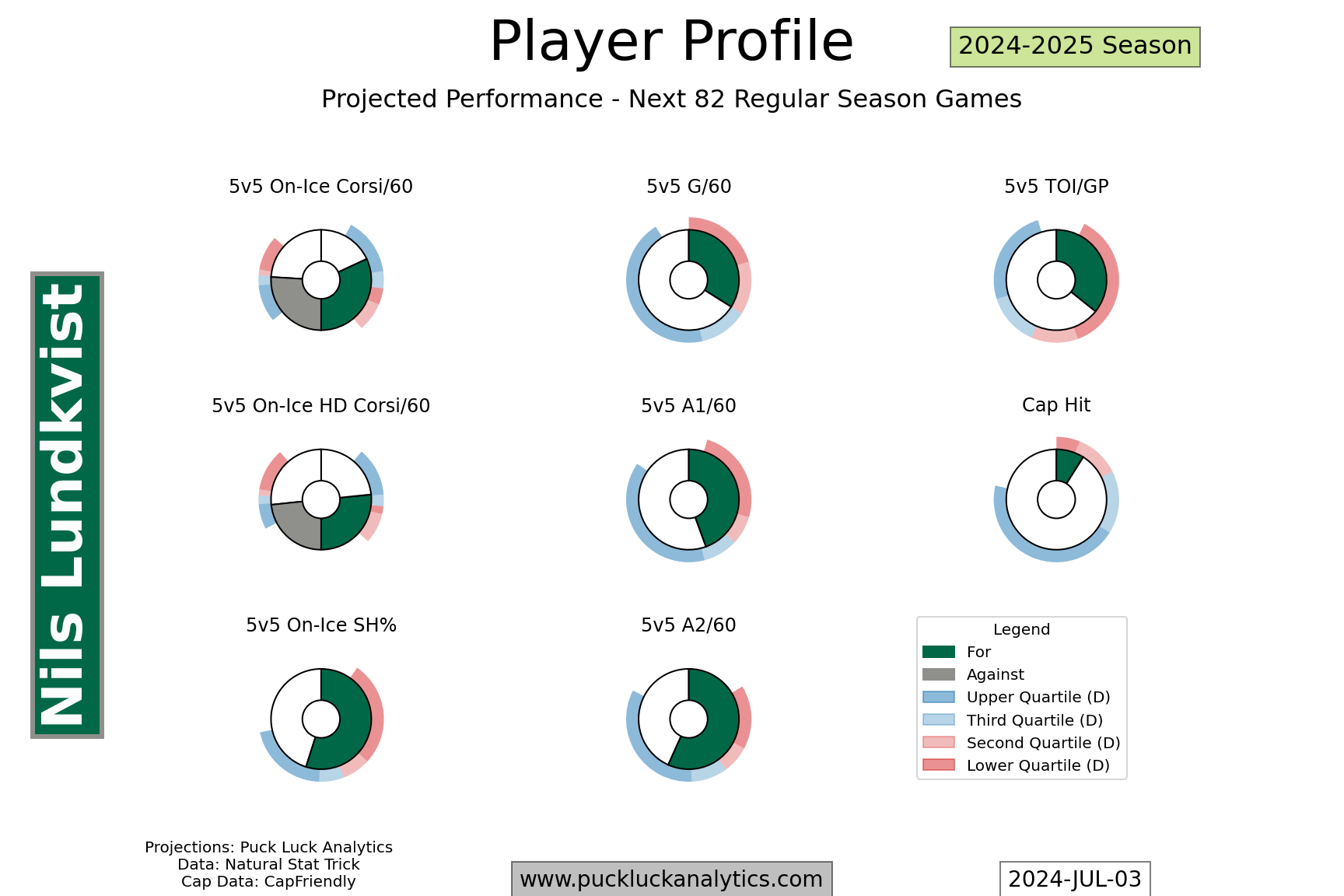
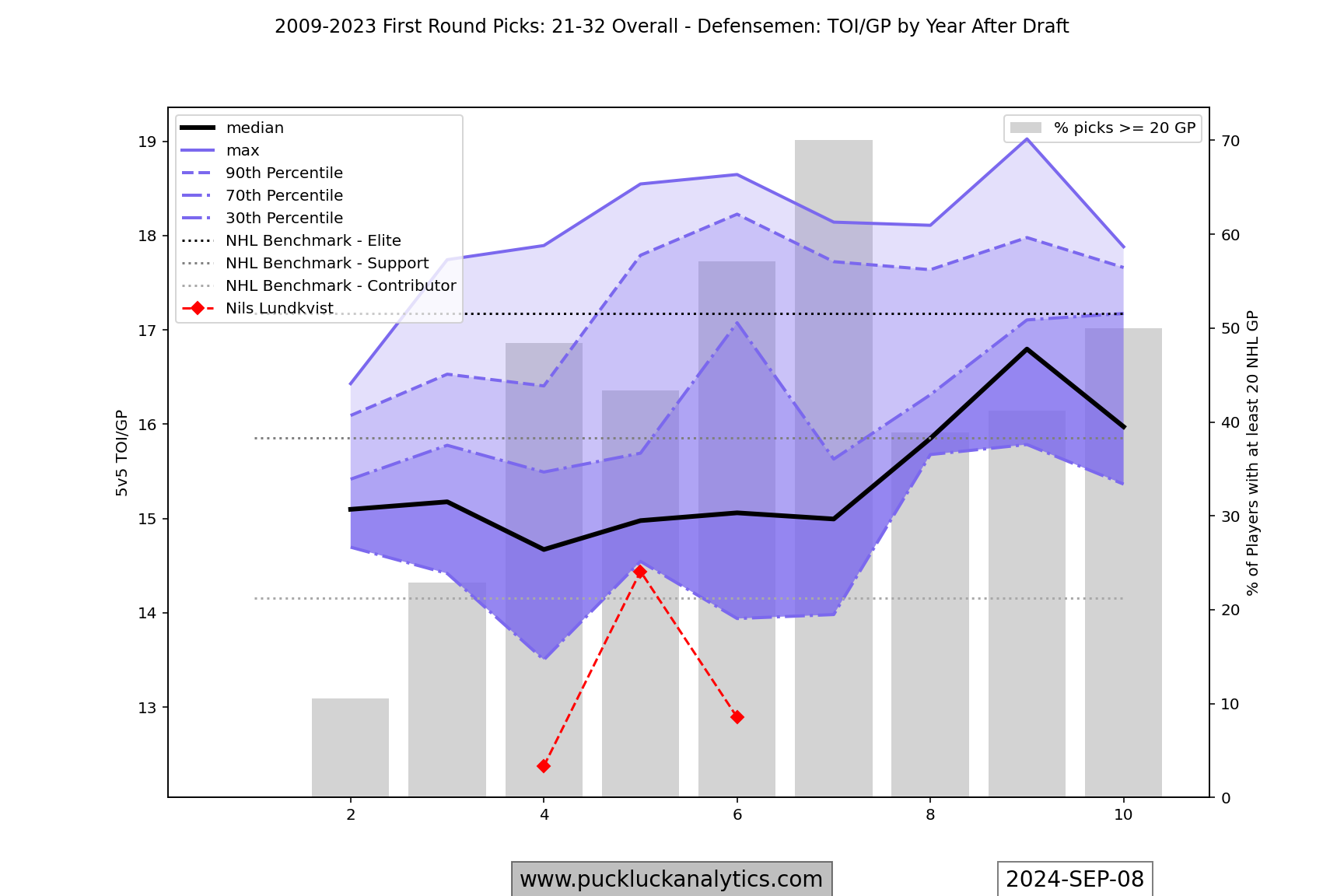
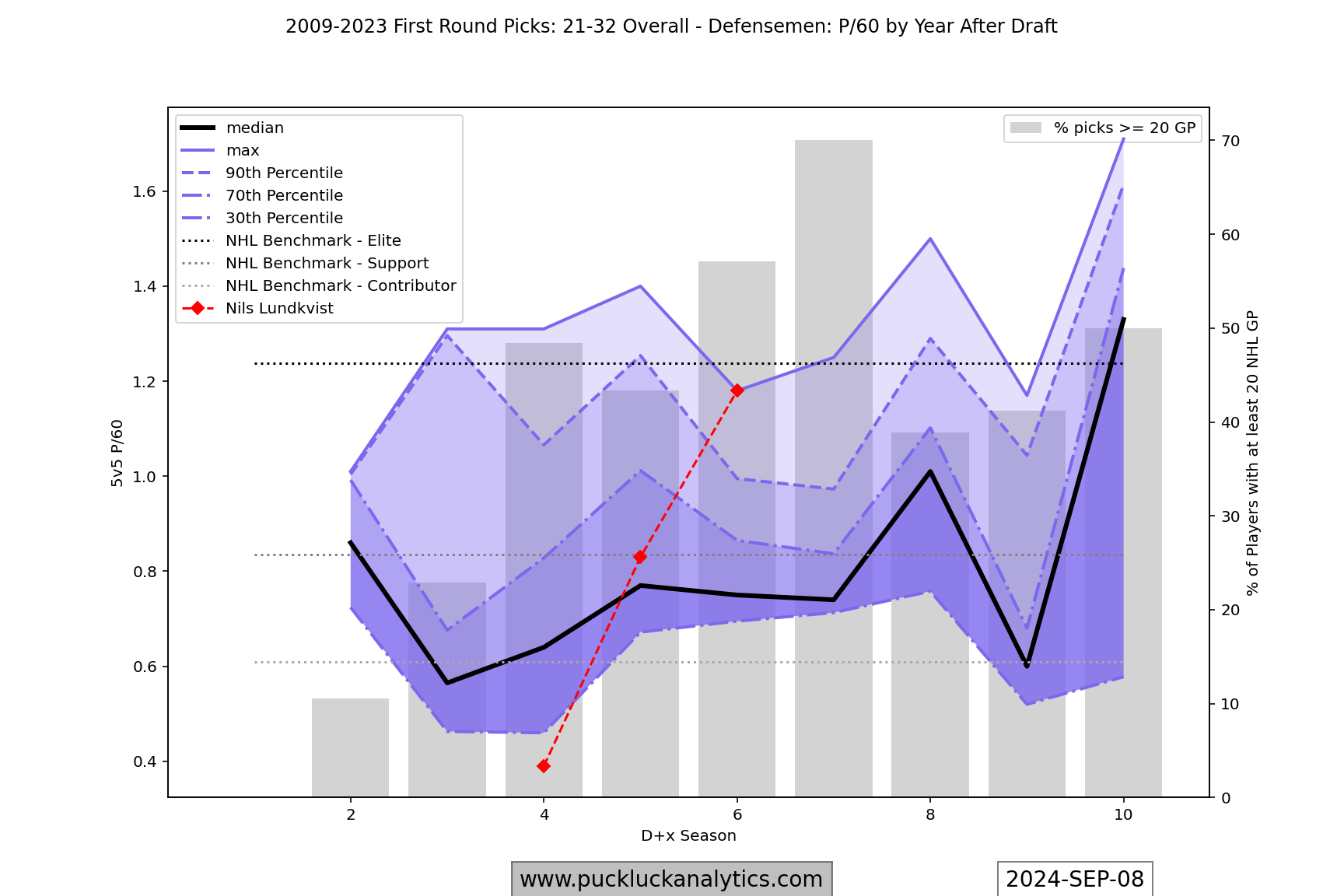
Goaltenders
G – Jake Oettinger (25 / $4.0MM / 1y): Oettinger is part of the Stars highly successful 2017 draft class. He’s established himself as the Stars #1 already, so it’s a fairly easy decision to continue down that path.
Veteran Cohort
With the primary cohort now driving the NHL roster, we’d like the veteran cohort reduced to roughly 3 forwards and 1-2 defensemen to help round out the roster with some experienced players. In large part, that’s already been done with the remnants of the 2020 SCF core providing veteran leadership the past couple of seasons.
F – Jamie Benn (35 / $9.5MM / 1y): The captain has one year left on his big contract. While he isn’t the force he once was, he’s found a role as a veteran mentor the past couple of seasons playing with some of the younger players we discussed above as they broke into the NHL. It will be nice to have his $9.5MM cap hit off the books next summer but, at a more reasonable price tag aligned with his current impact, we can keep him around a while longer if he’s interested. Already 35, there’s a good chance his playing days won’t see the end of our five year plan though. That’s where the plan to transition Hintz to the veteran cohort comes in. We’d like to find a replacement for Hintz in the primary cohort so Hintz can replace Benn in the veteran cohort.
F – Tyler Seguin (32 / $9.85MM / 3y): Another leader from the 2020 playoff run, Seguin still has three seasons left on his big contract and he’s a few years younger than Benn. It’s reasonable to think Seguin could stick in the lineup for a couple of additional years at a more reasonable cap hit.
F – Matt Duchene (33 / $3.0MM / 1y): Duchene was a good addition after he was bought out by the Predators and he’s come at the right price for the Stars so far. If he’s interested in sticking around, he’s a nice option to round out the veteran cohort and fill out top 9 depth in the roster.
D – Esa Lindell (30 / $5.8MM / 1y): One of three 30 year old defensemen on the current roster, Lindell seems like the best option to hang onto. That’s provided he agrees to stick around for a reasonable price when he hits UFA status next summer. Matt Dumba and Ilya Lyubushkin are the backup options, neither of which inspire a lot of confidence that they’ll be impactful enough into their mid 30s. It’s a situation to monitor and we may be better looking externally if there isn’t a suitable new deal that’s amenable to both sides.
Trade Targets
Now that we have three quarters of an NHL lineup identified between the primary and veteran cohorts, what are our priorities to add to the roster? There are two general objectives here. First, find upgrades that can solidify a few of the spots that have more uncertainty around them currently. Second, start building a new developing cohort that will eventually transition to drive the NHL roster when the current group exits their prime.
F – Contributor Tier: We filled one spot in the primary cohort with Matej Blumel and suggested Sam Steel was a capable fill in if Blumel doesn’t work out. We can also scour the trade market for another option.
F – Elite/Support Tier: We used Roope Hintz to bridge the veteran and primary cohorts together and planned to shift him into the veteran group if/when Jamie Benn departs it. Perhaps the veteran group evolves a bit differently and it’s one of the others in the veteran group that Hintz replaces. Regardless, we need another forward to replace Hintz in the primary cohort to continue regenerating the roster.
D – Support/Contributor Tier: While we found reason for optimism that Nils Lundkvist could be an impactful player for the primary cohort, he hasn’t done that yet. Finding another option or an upgrade for the third defense spot in the cohort is worth some investigation.
2026-2029 Draft Picks: With the primary cohort just entering it’s prime now, it will be some time before we’re ready to transition away from it. That time will come eventually though, and the 2026-2029 drafts are the starting point to build the next cohort.
Trade Chips
We have a longer term home for much of the current NHL roster in the roadmap, so trade options useing current roster players are limited. With a defined age range for the primary and developing cohorts though, we can use future assets that don’t fit the long term plan as trade chips.
Marchment / Dumba / Lyubushkin: – Veterans signed for two more seasons, the most practical time to move these players would be the summer of 2025. Looking for an option to include them in a deal to acquire one of our trade targets is the key.
2022-2024 Drafted Prospects / 2025 Draft Picks: This group of futures falls between our primary and developing cohorts, so we can consider them expendable. They can be used as deadline chips to upgrade for a playoff run or in deals with longer term outlook where we add to the primary and/or developing cohorts. The Stars 2025 1st Round Pick, Tristan Bertucci, and Christian Kyrou could be in play here.
Dallas Stars Roster Roadmap Summary

